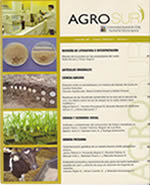Cover crop’s potential to remediate vineyard soils affected by copper. Mediterranean Chile
Main Article Content
Abstract
Our main goal was to evaluate the potential of cover crops (CC: ryegrass and/or white clover) to remediate a Mollisol under table grape production in central Chile that was affected by copper (Cu), with the crop displaying fruit yields directly related to soil Cu concentrations caused by regular and long-term application of fungicides. Surface soils from sites with high (LY: low fruit yields), intermediate (MY: medium fruit yields) and low (HY: high fruit yields) available Cu (CuDTPA) were used in a glasshouse essay, where CC was sowed. After 9 months they were harvested to obtain the dry matter and Cu contents from their tissues (shoots and roots), also measuring Cu forms in the soil. A reduction of CuDTPA (67%) and exchangeable Cu (90%) was obtained. Among sites, the shoot biomass of clover tends to decrease as Cu increases, whilst ryegrass alone or associated decreases its shoot biomass and increases its root biomass. At HY and MY no statistical differences in Cu uptake between ryegrass and mixed crops were detected, but the highest Cu uptake for ryegrass was observed at LY. Among the sites, ryegrass exhibited similar Cu uptake while in clover (alone or associated) roots the Cu uptake was higher in contaminated soils. In conclusion, CC growing in more contaminated soils exhibited highest root-to-shoot ratio, being lower in clover than ryegrass in all soils. The highest tolerance index was found in more contaminated soils for the roots of ryegrass (alone or associated) and clover was less affected by Cu stress than ryegrass and mixed CC.

